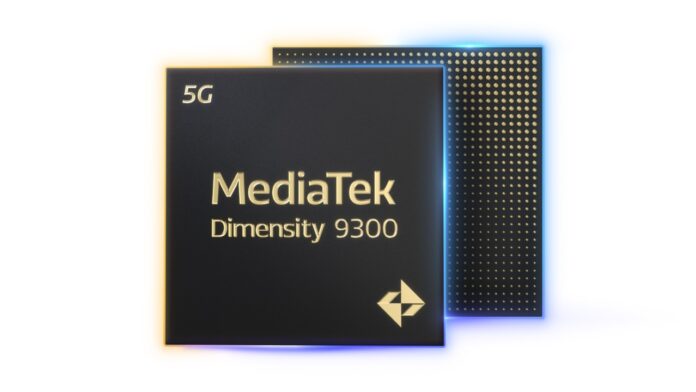Almost a year ago, the MediaTek Dimensity 9200 was revealed that resulted in a head-to-head competition with the Snapdragon 8 Gen 2. History is now repeating itself, as MediaTek has announced the Dimensity 9300 that will be rivalling the recently unveiled Snapdragon 8 Gen 3.
MediaTek Dimensity 9300: Specifications
MediaTek says that the Dimensity 9300 is the first to market with the latest Arm Cortex-X4 and Cortex-A720 processors. It has become the world’s first flagship smartphone chip to use all big cores: four Cortex-X4 and four -A720 processors. MediaTek has essentially given up on efficiency cores, yet it claims that the chip enables up to 33% multi-core power saving versus the previous generation CPU, 40% better peak performance, and 15% better performance at the same power.
The new chip from MediaTek is made on TSMC’s 3rd generation 4nm process, which is identical to Qualcomm’s Snapdragon 8 Gen 3. It has an 18MB L3 + SLC cache that is 29% larger than previous generation. The chip supports up to LPDDR5T RAM and UFS 4.0 storage. Once again, the Snapdragon chip gets beaten as it supports up to LPDDR5x RAM.
MediaTek’s next-generation APU architecture incorporates a hardware generative AI engine, enabling faster and safer EDGE AI computing. The APU 790 doubles the integer and floating-point operations performance, while reducing power consumption by 45%. By adapting the Transformer model for operator acceleration, the processing speed of the APU 790 is 8 times faster than the previous generation, with image generation within one second using Stable Diffusion.
MediaTek is the first to use Arm’s latest flagship GPU architecture – the Immortalis-G720 raytracing GPU. It provides an extra 46% peak performance, 40% power savings, and 40% memory Bandwidth savings in geometry-heavy game scenes. The company goes on to make another bold claim that the Dimensity 9300 is the world’s first mobile platform to achieve console-level global illumination effects.
For optics, the chip packs the 9th Generation Imagiq ISP with always-on HDR up to 4K resolution at 60 frames per second (fps). The chipset also supports 4K at 30 fps cinematic mode with real-time bokeh tracking for professional quality bokeh enhancements, as well as 4K AI Noise Reduction (AI-NR) and AI processing on RAW photos and videos. Similar to Snapdragon 8 Gen 3, the Dimensity 9300 will also support the new Ultra HDR format in Android 14 for the next generation of smartphones.
In addition, the chip gets 3-Microphone HDR Audio Recording, and can run WQHD displays up to 180Hz or 4K displays at up to 120Hz. This is actually better than what Snapdragon 8 Gen 3 supports, which is 4K at up to 60Hz or QHD+ at up to 144Hz.
Next, the 5G R16 modem supports 4CC-CA Sub-6GHz and8CC-CA mmWave with MediaTek’s UltraSave 3.0+ technology for improved power efficiency. It also supports Bluetooth v5.4 and Wi-Fi 7, same as the Snapdragon 8 Gen 3. However, Qualcomm went a step forward and allowed support for XPAN technology via which you can use earbuds with hi-res audio over Wi-Fi, which the Dimensity chip doesn’t support yet.
With a comparison between the two on the basis of on-paper specs, one can say that the MediaTek Dimensity 9300 outperforms the Snapdragon 8 Gen 3 when it comes to power, considering it has more power cores. However, one can argue that the efficiency would be superior on the 8 Gen 3, thanks to those efficiency cores. Aside from that, the Snapdragon 8 Gen 3 is a step ahead in terms of connectivity features, but the Dimensity 9300 makes up for it with a higher Refresh Rate for higher resolution displays and faster RAM hardware.
We would see the first phones with MediaTek Dimensity 9300 this month itself, where the Vivo X100 series are purported to debut with the processor. However, in 2023, we only saw two phones launch in India that had MediaTek’s last year’s flagship chip, the Dimensity 9200. These were the Find N3 Flip and the Vivo X90 Pro. Most OEMs adopt for Snapdragon 8 Gen 3 and it would be interesting to see whether they switch things up this time.


